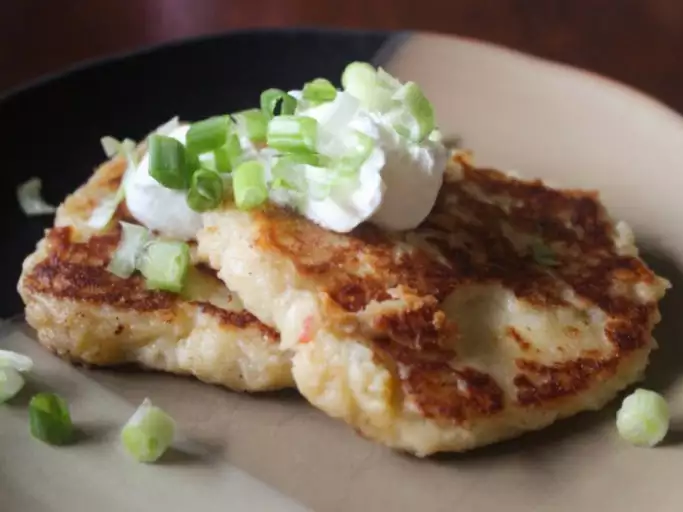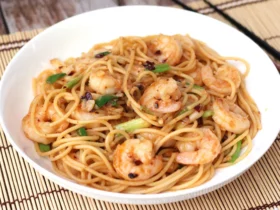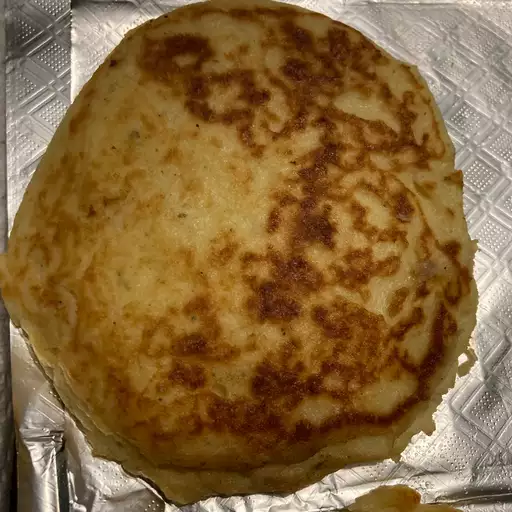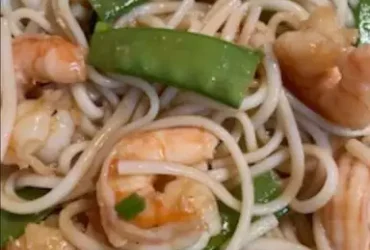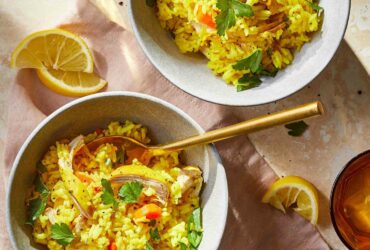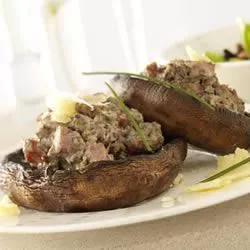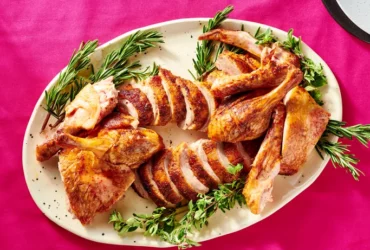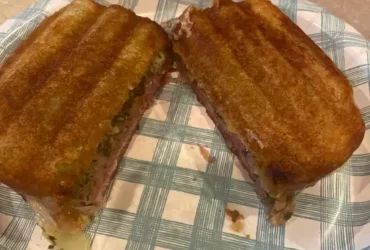Background and History
Potato cakes, a beloved comfort food, have been enjoyed in various cultures worldwide for centuries. Originating from the need to use leftover potatoes, these savory treats have evolved into a versatile dish. They can be found in different forms, such as Irish boxty, Scottish tattie scones, and American hash browns. Each region has its unique twist, but the core ingredients remain the same: potatoes, flour, and often some fat like butter or oil.
Serves
- Serves: 4-6 people
Time
- Preparation Time: 20 minutes
- Cooking Time: 25 minutes
- Total Time: 45 minutes
Ingredients
- 4 large potatoes (about 1 kg), peeled and grated
- 1 medium onion, finely chopped
- 1 cup all-purpose flour
- 1 large egg, beaten
- 1/2 cup milk
- 1 teaspoon baking powder
- 1 teaspoon salt
- 1/2 teaspoon black pepper
- 2 tablespoons butter or vegetable oil (for frying)
Instructions
Prepare the Potatoes
- Peel and grate the potatoes. Place the grated potatoes in a clean kitchen towel and squeeze out excess moisture.
Mix the Ingredients
- In a large bowl, combine the grated potatoes, chopped onion, flour, beaten egg, milk, baking powder, salt, and black pepper. Mix well until all ingredients are thoroughly combined.
Heat the Pan
- Heat a large skillet over medium heat and add the butter or vegetable oil. Allow it to melt and become hot.
Form the Cakes
- Scoop about 1/4 cup of the potato mixture and form it into a patty. Place it in the hot skillet. Repeat with the remaining mixture, being careful not to overcrowd the skillet.
Cook the Cakes
- Fry the potato cakes for about 3-4 minutes on each side, or until golden brown and crispy. Adjust the heat as necessary to prevent burning.
Drain and Serve
- Remove the cooked potato cakes from the skillet and place them on a plate lined with paper towels to drain any excess oil. Serve hot with your favorite toppings or dipping sauces.
Nutrition Facts (Per Serving)
- Calories: 200
- Total Fat: 8g
- Saturated Fat: 2g
- Cholesterol: 40mg
- Sodium: 400mg
- Total Carbohydrates: 28g
- Dietary Fiber: 3g
- Sugars: 2g
- Protein: 5g
Notes
- Variations: Add grated cheese, chopped herbs, or cooked bacon bits to the mixture for extra flavor.
- Serving Suggestions: Serve with sour cream, applesauce, or a side salad for a complete meal.
- Storage: Store leftovers in an airtight container in the refrigerator for up to 3 days. Reheat in a skillet or oven for best results.
Allergy Warning
- Contains: Gluten (from flour), Eggs, Dairy (if using butter)
- Note: Substitute with gluten-free flour, egg replacer, and oil to make the recipe suitable for those with specific allergies.
Enjoy these delicious and crispy potato cakes as a side dish or a hearty snack. Their simplicity and versatility make them a favorite for many!
What is potato cake batter made of?
Potato cake batter is made of grated potatoes, finely chopped onion, flour, a beaten egg, milk, baking powder, salt, and black pepper. These ingredients are mixed together to form a thick batter.
Why do my Potato Cakes fall apart?
Potato cakes can fall apart if there is too much moisture in the grated potatoes. Be sure to squeeze out as much water as possible from the grated potatoes before mixing them with the other ingredients. Additionally, ensuring the correct balance of flour and egg can help bind the mixture together.
Do Potato Cakes contain potato?
Yes, potato cakes are primarily made from potatoes, usually grated or mashed, which form the base of the batter.
What is the difference between potato cake and potato scone?
Potato cakes are typically fried and have a crispy exterior with a soft interior, whereas potato scones (or tattie scones) are usually baked or cooked on a griddle and are more like a flatbread or biscuit in texture.
Do potato cakes contain milk?
Yes, traditional potato cake recipes often include milk to help bind the ingredients and create a smoother batter. However, milk can be substituted with plant-based alternatives for those with dairy allergies or lactose intolerance.
What to eat with potato cakes?
Potato cakes can be enjoyed with a variety of accompaniments such as sour cream, applesauce, chutney, smoked salmon, or a simple side salad. They can also be served as a side dish with meats or stews.
What country are Potato Cakes from?
Potato cakes have variations in many countries, but they are particularly popular in Ireland, Scotland, and the United States. Each region has its own take on this versatile dish.
What do the English call Potato Cakes?
In England, potato cakes are often referred to as “tattie scones” or simply “potato scones,” particularly in regions with Scottish influence.
Which is the best potato for baking?
The best potatoes for baking are usually starchy varieties like Russet or Idaho potatoes. These potatoes have a fluffy texture when baked and absorb flavors well.
What are the 3 types of potatoes?
The three main types of potatoes are
- Starchy Potatoes: Such as Russet and Idaho, great for baking and frying.
- Waxy Potatoes: Such as Red Bliss and Fingerlings, which hold their shape well and are ideal for boiling and salads.
- All-Purpose Potatoes: Such as Yukon Gold and white potatoes, which have a balance of starch and waxiness, making them versatile for most cooking methods.
- Best Lusha Alternatives for 2025 - April 22, 2025
- Best Overloop Alternatives for 2025 - April 22, 2025
- Best 6sense Alternatives for 2025 - April 22, 2025

